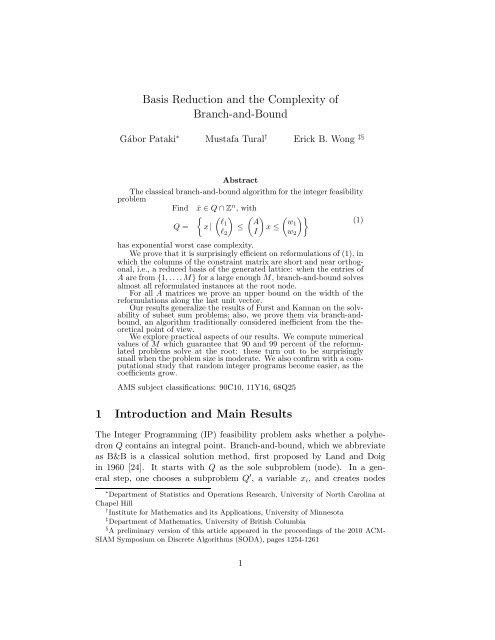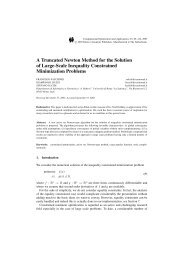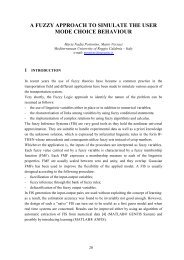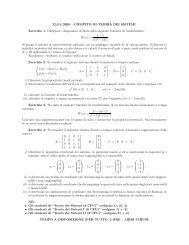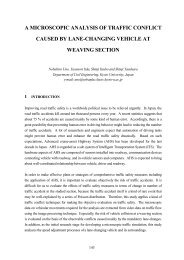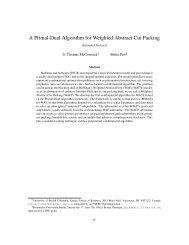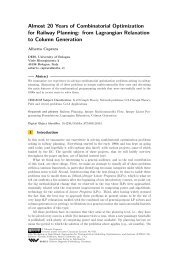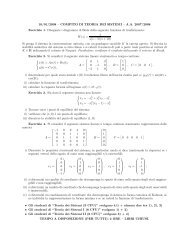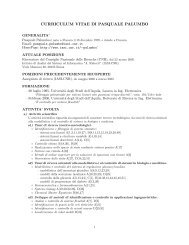Basis Reduction and the Complexity of Branch-and-Bound 1 ...
Basis Reduction and the Complexity of Branch-and-Bound 1 ...
Basis Reduction and the Complexity of Branch-and-Bound 1 ...
Create successful ePaper yourself
Turn your PDF publications into a flip-book with our unique Google optimized e-Paper software.
<strong>Basis</strong> <strong>Reduction</strong> <strong>and</strong> <strong>the</strong> <strong>Complexity</strong> <strong>of</strong><br />
<strong>Branch</strong>-<strong>and</strong>-<strong>Bound</strong><br />
Gábor Pataki ∗ Mustafa Tural † Erick B. Wong ‡§<br />
Abstract<br />
The classical branch-<strong>and</strong>-bound algorithm for <strong>the</strong> integer feasibility<br />
problem<br />
Find<br />
Q =<br />
¯x ∈ Q ∩ Z n , with<br />
{ ( )<br />
l1<br />
x | ≤<br />
l 2<br />
( A<br />
I<br />
)<br />
x ≤<br />
(<br />
w1<br />
w 2<br />
)}<br />
has exponential worst case complexity.<br />
We prove that it is surprisingly efficient on reformulations <strong>of</strong> (1), in<br />
which <strong>the</strong> columns <strong>of</strong> <strong>the</strong> constraint matrix are short <strong>and</strong> near orthogonal,<br />
i.e., a reduced basis <strong>of</strong> <strong>the</strong> generated lattice: when <strong>the</strong> entries <strong>of</strong><br />
A are from {1, . . ., M} for a large enough M, branch-<strong>and</strong>-bound solves<br />
almost all reformulated instances at <strong>the</strong> root node.<br />
For all A matrices we prove an upper bound on <strong>the</strong> width <strong>of</strong> <strong>the</strong><br />
reformulations along <strong>the</strong> last unit vector.<br />
Our results generalize <strong>the</strong> results <strong>of</strong> Furst <strong>and</strong> Kannan on <strong>the</strong> solvability<br />
<strong>of</strong> subset sum problems; also, we prove <strong>the</strong>m via branch-<strong>and</strong>bound,<br />
an algorithm traditionally considered inefficient from <strong>the</strong> <strong>the</strong>oretical<br />
point <strong>of</strong> view.<br />
We explore practical aspects <strong>of</strong> our results. We compute numerical<br />
values <strong>of</strong> M which guarantee that 90 <strong>and</strong> 99 percent <strong>of</strong> <strong>the</strong> reformulated<br />
problems solve at <strong>the</strong> root: <strong>the</strong>se turn out to be surprisingly<br />
small when <strong>the</strong> problem size is moderate. We also confirm with a computational<br />
study that r<strong>and</strong>om integer programs become easier, as <strong>the</strong><br />
coefficients grow.<br />
AMS subject classifications: 90C10, 11Y16, 68Q25<br />
(1)<br />
1 Introduction <strong>and</strong> Main Results<br />
The Integer Programming (IP) feasibility problem asks whe<strong>the</strong>r a polyhedron<br />
Q contains an integral point. <strong>Branch</strong>-<strong>and</strong>-bound, which we abbreviate<br />
as B&B is a classical solution method, first proposed by L<strong>and</strong> <strong>and</strong> Doig<br />
in 1960 [24]. It starts with Q as <strong>the</strong> sole subproblem (node). In a general<br />
step, one chooses a subproblem Q ′ , a variable x i , <strong>and</strong> creates nodes<br />
∗ Department <strong>of</strong> Statistics <strong>and</strong> Operations Research, University <strong>of</strong> North Carolina at<br />
Chapel Hill<br />
† Institute for Ma<strong>the</strong>matics <strong>and</strong> its Applications, University <strong>of</strong> Minnesota<br />
‡ Department <strong>of</strong> Ma<strong>the</strong>matics, University <strong>of</strong> British Columbia<br />
§ A preliminary version <strong>of</strong> this article appeared in <strong>the</strong> proceedings <strong>of</strong> <strong>the</strong> 2010 ACM-<br />
SIAM Symposium on Discrete Algorithms (SODA), pages 1254-1261<br />
1
Q ′ ∩ {x|x i = γ}, where γ ranges over all possible integer values <strong>of</strong> x i . We repeat<br />
this until all subproblems are shown to be empty, or we find an integral<br />
point in one <strong>of</strong> <strong>the</strong>m.<br />
x 2<br />
13<br />
12<br />
11<br />
10<br />
9<br />
8<br />
7<br />
6<br />
5<br />
4<br />
3<br />
y 2<br />
18<br />
17<br />
16<br />
15<br />
14<br />
13<br />
12<br />
11<br />
10<br />
9<br />
8<br />
2<br />
1<br />
0<br />
0 1 2 3 4 5 6 7 8 9 10 11 12 13<br />
x 1<br />
7<br />
6<br />
5<br />
−244 −242 −240 −238 −236 −234 −232 −230 −228<br />
y 1<br />
Figure 1: The polyhedron <strong>of</strong> Example 1 before <strong>and</strong> after <strong>the</strong> reformulation<br />
B&B (<strong>and</strong> its version used to solve optimization problems) enhanced by<br />
cutting planes is a dependable algorithm implemented in most commercial<br />
s<strong>of</strong>tware packages. However, instances in [16, 9, 15, 21, 3, 4] show that it<br />
is <strong>the</strong>oretically inefficient: it may take an exponential number <strong>of</strong> subproblems<br />
to prove <strong>the</strong> infeasibility <strong>of</strong> simple knapsack problems. While B&B<br />
is inefficient in <strong>the</strong> worst case, Cornuéjols et al. in [11] developed useful<br />
computational tools to give an early estimate on <strong>the</strong> size <strong>of</strong> <strong>the</strong> B&B tree<br />
in practice.<br />
Since IP feasibility is NP-complete, one can ask for polynomiality <strong>of</strong> a<br />
solution method only in fixed dimension. All algorithms that achieve such<br />
complexity rely on advanced techniques. The algorithms <strong>of</strong> Lenstra [26]<br />
<strong>and</strong> Kannan [19] first round <strong>the</strong> polyhedron (i.e., apply a transformation to<br />
make it have a spherical appearance), <strong>the</strong>n use basis reduction to reduce <strong>the</strong><br />
problem to a provably small number <strong>of</strong> smaller dimensional subproblems.<br />
On <strong>the</strong> subproblems <strong>the</strong> algorithms are applied recursively, e.g., rounding<br />
is done again. Generalized basis reduction, proposed by Lovász <strong>and</strong> Scarf<br />
in [27] avoids rounding, but needs to solve a sequence <strong>of</strong> linear programs to<br />
create <strong>the</strong> subproblems. For surveys on <strong>the</strong> connection <strong>of</strong> basis reduction,<br />
<strong>and</strong> integer programming we refer to Kannan [18] <strong>and</strong> Eisenbr<strong>and</strong> [12].<br />
There is a simpler way to use basis reduction in integer programming:<br />
preprocessing (1) to create an instance with short <strong>and</strong> near orthogonal<br />
columns in <strong>the</strong> constraint matrix, <strong>the</strong>n simply feeding it to an IP solver.<br />
2
The first such reformulation method, that we call nullspace reformulation,<br />
was proposed by Aardal, Hurkens <strong>and</strong> Lenstra for equality constrained integer<br />
programs in [2], <strong>and</strong> fur<strong>the</strong>r studied in [1]. The rangespace reformulation<br />
<strong>of</strong> Krishnamoorthy <strong>and</strong> Pataki [21] applies to general integer programs. We<br />
describe <strong>the</strong>se below, assuming that A is an integral matrix with m rows<br />
<strong>and</strong> n columns, <strong>and</strong> <strong>the</strong> w i <strong>and</strong> l i are integral vectors.<br />
The rangespace reformulation <strong>of</strong> (1) is<br />
Find ȳ ∈ Q R ∩ Z n , with<br />
{ ( )<br />
l1<br />
Q R = y | ≤<br />
l 2<br />
( A<br />
I<br />
)<br />
Uy ≤<br />
(<br />
w1<br />
w 2<br />
)}<br />
,<br />
where U is a unimodular matrix computed to make <strong>the</strong> columns <strong>of</strong> <strong>the</strong><br />
constraint matrix a reduced basis <strong>of</strong> <strong>the</strong> generated lattice.<br />
The nullspace reformulation is applicable when w 1 = l 1 . Assuming that<br />
<strong>the</strong> rows <strong>of</strong> A are linearly independent, it is<br />
Find ȳ ∈ Q N ∩ Z n−m , with<br />
Q N = {y |l 2 − x 0 ≤ By ≤ w 2 − x 0 } ,<br />
where x 0 ∈ Z n satisfies Ax 0 = l 1 , <strong>and</strong> <strong>the</strong> columns <strong>of</strong> B are a reduced basis<br />
<strong>of</strong> <strong>the</strong> lattice {x ∈ Z n |Ax = 0 }.<br />
We analyze <strong>the</strong> use <strong>of</strong> Lenstra-Lenstra-Lovász (LLL) [25], <strong>and</strong> reciprocal<br />
Korkin-Zolotarev (RKZ) reduced bases [22] in <strong>the</strong> reformulations, <strong>and</strong> use<br />
Korkin-Zolotarev (KZ) reduced bases [19, 20] in our computational study.<br />
We will review <strong>the</strong> relevant properties <strong>of</strong> <strong>the</strong>se bases in Section 2.<br />
When Q R is computed using LLL reduction, we call it <strong>the</strong> LLL-rangespace<br />
reformulation <strong>of</strong> Q, <strong>and</strong> abusing notation we also call (2) <strong>the</strong> LLL-rangespace<br />
reformulation <strong>of</strong> (1). Similarly we talk about LLL-nullspace, RKZ-rangespace,<br />
<strong>and</strong> RKZ-nullspace reformulations.<br />
Example 1. The polyhedron<br />
672 ≤ 61x 1 + 59x 2 ≤ 707<br />
0 ≤ x 1 ,x 2 ≤ 12<br />
is shown on <strong>the</strong> first picture <strong>of</strong> Figure 1. It is long <strong>and</strong> thin, <strong>and</strong> defines<br />
an infeasible <strong>and</strong> relatively difficult integer feasibility problem for B&B, as<br />
branching on ei<strong>the</strong>r x 1 or x 2 yields 12 subproblems. Lenstra’s <strong>and</strong> Kannan’s<br />
algorithms would first transform this polyhedron to make it more spherical;<br />
generalized basis reduction would solve a sequence <strong>of</strong> linear programs to find<br />
<strong>the</strong> direction x 1 + x 2 along which <strong>the</strong> polyhedron is thin.<br />
The LLL-rangespace reformulation is<br />
672 ≤ −2x 1 + 19x 2 ≤ 707<br />
0 ≤ −x 1 − 20x 2 ≤ 12<br />
0 ≤ x 1 + 21x 2 ≤ 12<br />
3<br />
(2)<br />
(3)<br />
(4)<br />
(5)
shown on <strong>the</strong> second picture <strong>of</strong> Figure 1: it is still long, <strong>and</strong> thin, but now<br />
branching on y 2 proves integer infeasibility. (A similar example was given<br />
in [21]).<br />
The reformulation methods are easier to describe, than, say Lenstra’s<br />
algorithm, <strong>and</strong> are also successful in practice in solving several classes <strong>of</strong> hard<br />
integer programs: see [2, 1, 21]. For instance, <strong>the</strong> original formulations <strong>of</strong><br />
<strong>the</strong> marketshare problems <strong>of</strong> Cornuéjols <strong>and</strong> Daw<strong>and</strong>e in [10] are notoriously<br />
difficult for commercial solvers, while <strong>the</strong> nullspace reformulations are much<br />
easier to solve as shown by Aardal et al. in [1].<br />
However, <strong>the</strong>y seem difficult to analyze in general. For an overview <strong>of</strong><br />
previous results, we need <strong>the</strong> following concepts: if Q is a polyhedron <strong>and</strong> z<br />
is a nonzero integral vector, <strong>the</strong>n <strong>the</strong> width, <strong>and</strong> integer width <strong>of</strong> Q along z<br />
are<br />
width(z,Q) = max {〈z,x〉} − min {〈z,x〉} , <strong>and</strong><br />
x∈Q x∈Q<br />
⌊ ⌋ ⌈ ⌉<br />
iwidth(z,Q) = max {〈z,x〉} − min {〈z,x〉} + 1.<br />
x∈Q x∈Q<br />
The quantity iwidth(z,Q) is <strong>the</strong> number <strong>of</strong> subproblems generated, when<br />
branching on <strong>the</strong> hyperplane 〈z,x〉 in seeking to find an integral point in Q.<br />
In particular, iwidth(z,Q) = 0 implies that Q has no integral point.<br />
Krishnamoorthy <strong>and</strong> Pataki in [21] studied knapsack problems with a<br />
constraint vector a having a given decomposition a = λp + r, with p <strong>and</strong> r<br />
integral vectors, <strong>and</strong> λ an integer, large compared to ‖ p ‖ <strong>and</strong> ‖ r ‖. They<br />
proved<br />
width(e n ,Q R ) ≤ width(p,Q), (6)<br />
iwidth(e n ,Q R ) ≤ iwidth(p,Q), (7)<br />
<strong>and</strong> analogous results for <strong>the</strong> nullspace reformulation. (In fact, as shown in<br />
[31], equality holds in (6) <strong>and</strong> (7).)<br />
These inequalities partially explain why <strong>the</strong> reformulation techniques<br />
are effective: considering (6), note that width(p,Q) is small, due to λ being<br />
large, i.e., p being near parallel to <strong>the</strong> constraint vector. Also, for a<br />
wide variety <strong>of</strong> problems iwidth(p,Q) = 0, but branching on <strong>the</strong> individual<br />
variables would need an exponential number <strong>of</strong> B&B nodes: as (7) shows,<br />
for <strong>the</strong>se problems branching on <strong>the</strong> last variable in Q R proves infeasibility<br />
at <strong>the</strong> root node. In o<strong>the</strong>r words, <strong>the</strong> effect <strong>of</strong> branching on 〈p,x〉 in Q is<br />
mimicked by branching on a single variable in Q R .<br />
In a general analysis, one could hope for proving polynomiality <strong>of</strong> B&B<br />
on <strong>the</strong> reformulations <strong>of</strong> (1) when <strong>the</strong> dimension is fixed. This seems difficult.<br />
However, we give a different <strong>and</strong> perhaps even more surprising complexity<br />
analysis. It is in <strong>the</strong> spirit <strong>of</strong> Furst <strong>and</strong> Kannan’s work in [14] on subset<br />
4
sum problems <strong>and</strong> builds on a generalization <strong>of</strong> <strong>the</strong>ir Lemma 1 to bound<br />
<strong>the</strong> fraction <strong>of</strong> integral matrices for which <strong>the</strong> shortest nonzero vectors <strong>of</strong><br />
certain corresponding lattices are short. We also use an upper bound on<br />
<strong>the</strong> size <strong>of</strong> <strong>the</strong> B&B tree, which depends on <strong>the</strong> norms <strong>of</strong> <strong>the</strong> Gram-Schmidt<br />
vectors <strong>of</strong> <strong>the</strong> constraint matrix. We introduce necessary notation <strong>and</strong> state<br />
our results, <strong>the</strong>n give a comparison with [14].<br />
When a statement is true for all, but at most a fraction <strong>of</strong> 1/2 n <strong>of</strong> <strong>the</strong><br />
elements <strong>of</strong> a set S, we say that it is true for almost all elements. The value<br />
<strong>of</strong> n will be clear from <strong>the</strong> context. Reverse B&B is B&B branching on <strong>the</strong><br />
variables in reverse order starting with <strong>the</strong> one <strong>of</strong> highest index. We assume<br />
w 2 > l 2 <strong>and</strong> for simplicity <strong>of</strong> stating <strong>the</strong> results we also assume n ≥ 5. For<br />
positive integers m, n <strong>and</strong> M we denote by G m,n (M) <strong>the</strong> set <strong>of</strong> matrices with<br />
m rows <strong>and</strong> n columns, <strong>and</strong> <strong>the</strong> entries drawn from {1,... ,M}. We denote<br />
by G ′ m,n(M) <strong>the</strong> subset <strong>of</strong> G m,n (M) consisting <strong>of</strong> matrices with linearly<br />
independent rows, <strong>and</strong> let<br />
χ m,n (M) = |G′ m,n(M)|<br />
|G m,n (M)| . (8)<br />
In Lemma 4 in Section 2 we will prove a lower bound on χ m,n (M) for any<br />
n,m <strong>and</strong> M using only elementary<br />
(<br />
techniques. For matrices (<strong>and</strong> vectors)<br />
A<br />
A <strong>and</strong> B, we write (A;B) for . For an m by n integral matrix A with<br />
B)<br />
independent rows we write gcd(A) for <strong>the</strong> greatest common divisor <strong>of</strong> <strong>the</strong><br />
m by m subdeterminants <strong>of</strong> A. If B&B generates at most one node at each<br />
level <strong>of</strong> <strong>the</strong> tree, we say that it solves an integer feasibility problem at <strong>the</strong><br />
root node. If l 1 = w 1 , <strong>and</strong> <strong>the</strong> system Ax = l 1 does not have an integral<br />
solution, <strong>the</strong>n <strong>the</strong> nullspace reformulation cannot be constructed. In this<br />
case we also say that B&B solves <strong>the</strong> nullspace reformulation at <strong>the</strong> root<br />
node.<br />
Given independent vectors b 1 ,...,b r , <strong>the</strong> vectors b ∗ 1 ,... ,b∗ r form <strong>the</strong><br />
Gram-Schmidt orthogonalization <strong>of</strong> b 1 ,...,b r , if b ∗ 1 = b 1, <strong>and</strong> b ∗ i is <strong>the</strong><br />
projection <strong>of</strong> b i onto <strong>the</strong> orthogonal complement <strong>of</strong> <strong>the</strong> subspace spanned<br />
by b 1 ,...,b i−1 for i ≥ 2.<br />
The main results <strong>of</strong> <strong>the</strong> paper follow.<br />
Theorem 1. The following hold.<br />
(1) If M ≥ (2n ‖(w 1 ;w 2 ) − (l 1 ;l 2 )‖) n/m+1 , <strong>the</strong>n for almost all A ∈ G m,n (M)<br />
reverse B&B solves <strong>the</strong> RKZ-rangespace reformulation <strong>of</strong> (1) at <strong>the</strong><br />
root node.<br />
(2) If M ≥ (12(n − m) ‖w 2 − l 2 ‖) n/m , <strong>the</strong>n for almost all A ∈ G ′ m,n (M)<br />
reverse B&B solves <strong>the</strong> RKZ-nullspace reformulation <strong>of</strong> (1) at <strong>the</strong> root<br />
node.<br />
5
The pro<strong>of</strong>s also show that when M obeys <strong>the</strong> above bounds, <strong>the</strong>n Q∩Z n<br />
has at most one element for almost all A ∈ G m,n (M) (or almost all A ∈<br />
G ′ m,n (M)). Note that when n/m is fixed <strong>and</strong> <strong>the</strong> problems are binary, <strong>and</strong><br />
equality constrained, <strong>the</strong> magnitude <strong>of</strong> M required is a polynomial in n.<br />
Theorem 2. The conclusions <strong>of</strong> Theorem 1 hold for <strong>the</strong> LLL-reformulations,<br />
if <strong>the</strong> bounds on M are<br />
(2 (n+4)/2 ‖(w 1 ;w 2 ) − (l 1 ;l 2 )‖) n/m+1 ,<br />
<strong>and</strong><br />
respectively.<br />
(2 (n−m+4)/2 ‖w 2 − l 2 ‖) n/m ,<br />
Furst <strong>and</strong> Kannan in [14] based on Lagarias’ <strong>and</strong> Odlyzko’s [23] <strong>and</strong><br />
Frieze’s [13] work show that <strong>the</strong> subset sum problem is solvable in polynomial<br />
time using a simple iterative method for almost all weight vectors in G 1,n (M)<br />
<strong>and</strong> all right h<strong>and</strong> sides, when M is sufficiently large <strong>and</strong> a reduced basis <strong>of</strong><br />
<strong>the</strong> orthogonal lattice <strong>of</strong> <strong>the</strong> weight vector is available. Their bound on M<br />
is<br />
M ≥ 2 (3/2)n log n+5n , (9)<br />
when <strong>the</strong> basis is RKZ reduced, <strong>and</strong><br />
M ≥ 2 n2 /2+2n n 3n/2 , (10)<br />
when it is LLL reduced.<br />
Our bounds obtained by letting m = 1 in Theorems 1 <strong>and</strong> 2 are comparable,<br />
when <strong>the</strong> size <strong>of</strong> M, i.e., ⌈log(M + 1)⌉ is concerned. With RKZ<br />
reduction, both <strong>the</strong> bounds in Theorem 1 <strong>and</strong> <strong>the</strong> one in (9) require <strong>the</strong> size<br />
<strong>of</strong> M to be O(n log n). With LLL reduction, our bounds in Theorem 2 <strong>and</strong><br />
<strong>the</strong> one in (10) require <strong>the</strong> size <strong>of</strong> M to be O(n 2 ). Hence, our results generalize<br />
<strong>the</strong> solvability results <strong>of</strong> [14] from subset sum problems to bounded<br />
integer programs; also, we prove <strong>the</strong>m via branch-<strong>and</strong>-bound, an algorithm<br />
considered inefficient from <strong>the</strong> <strong>the</strong>oretical point <strong>of</strong> view.<br />
Solving almost all instances <strong>of</strong> a problem in polynomial time may not,<br />
in general, lead to an algorithm with polynomial expected running time: for<br />
a discussion, we refer to David S. Johnson’s survey [17]. However, we can<br />
combine branch-<strong>and</strong>-bound on <strong>the</strong> original <strong>and</strong> reformulated problems to<br />
obtain a composite algorithm, which does have polynomial expected running<br />
time.<br />
COMPOSITE ALGORITHM<br />
6
(a) Compute <strong>the</strong> LLL-rangespace reformulation <strong>of</strong> (1), <strong>and</strong> let b ∗ i (i =<br />
1,... ,n) be <strong>the</strong> Gram-Schmidt orthogonalization <strong>of</strong> <strong>the</strong> constraint matrix.<br />
Check whe<strong>the</strong>r ‖b ∗ i ‖>‖(w 1;w 2 ) − (l 1 ;l 2 )‖, for all i = 1,... ,n,<br />
(b) If <strong>the</strong> answer is YES, run reverse B&B on <strong>the</strong> reformulated problem,<br />
<strong>and</strong> STOP.<br />
(c) O<strong>the</strong>rwise, run B&B on <strong>the</strong> original problem, choosing <strong>the</strong> branching<br />
variables in an arbitrary sequence.<br />
Theorem 3. Let B := ∏ n<br />
i=1 (⌊(w 2,i − l 2,i )⌋ + 1), <strong>and</strong> assume<br />
M ≥ B 1/m (2 (n+1)/2 ‖(w 1 ;w 2 ) − (l 1 ;l 2 )‖ +2) (n+m)/m .<br />
Then <strong>the</strong> Composite Algorithm runs in expected polynomial time, if A is<br />
uniformly <strong>and</strong> independently chosen from G m,n (M).<br />
Remark 1. It is easy to check that Theorems 1 through 3 remain true, if<br />
<strong>the</strong> set {1,... ,M} is replaced by an arbitrary set <strong>of</strong> M distinct integers.<br />
Smoo<strong>the</strong>d complexity [34, 35] is a more recent notion that successfully<br />
explains why some algorithms with an exponential worst case running time<br />
are usually much faster. Beier <strong>and</strong> Vöcking in [5] presented smoo<strong>the</strong>d complexity<br />
results for binary integer programs, <strong>and</strong> generalizing <strong>the</strong>se, Röglin<br />
<strong>and</strong> Vöcking in [32] characterized <strong>the</strong> smoo<strong>the</strong>d complexity <strong>of</strong> general integer<br />
programs in terms <strong>of</strong> <strong>the</strong>ir worst case complexity. Their results imply<br />
polynomial smoo<strong>the</strong>d complexity <strong>of</strong> packing <strong>and</strong> covering integer programs<br />
with a fixed number <strong>of</strong> constraints. Our assumptions <strong>and</strong> results are quite<br />
different, <strong>and</strong> most importantly, <strong>the</strong> tool we use is <strong>the</strong> classical branch-<strong>and</strong>bound<br />
algorithm.<br />
Proposition 1 gives ano<strong>the</strong>r indication why <strong>the</strong> reformulations are relatively<br />
easy. One can observe that det(AA T ) can be quite large even for<br />
moderate values <strong>of</strong> M, if A ∈ G m,n (M) is a r<strong>and</strong>om matrix with m ≤ n.<br />
For instance, for a r<strong>and</strong>om A ∈ G 4,30 (100) we found det(AA T ) to be <strong>of</strong> <strong>the</strong><br />
order 10 18 . We can bound <strong>the</strong> width <strong>of</strong> <strong>the</strong> reformulations along <strong>the</strong> last<br />
unit vector for any A (i.e., not just almost all).<br />
Proposition 1. If Q R is computed using RKZ reduction, <strong>the</strong>n<br />
width(e n ,Q R ) ≤<br />
√ n ‖(w1 ;w 2 ) − (l 1 ;l 2 )‖<br />
det(AA T + I) 1/(2n) . (11)<br />
Also, if A has independent rows, <strong>and</strong> Q N is computed using RKZ reduction,<br />
<strong>the</strong>n<br />
width(e n−m ,Q N ) ≤ gcd(A)√ n − m ‖w 2 − l 2 ‖<br />
det(AA T ) 1/(2(n−m)) . (12)<br />
7
The same results hold for <strong>the</strong> LLL-reformulations, if √ n <strong>and</strong> √ n − m are<br />
replaced by 2 (n−1)/4 <strong>and</strong> 2 (n−m−1)/4 , respectively.<br />
Remark 2. As described in [30] for <strong>the</strong> nullspace reformulation, <strong>and</strong> in Section<br />
5 <strong>of</strong> [21] for both reformulations, directions achieving <strong>the</strong> same widths<br />
exist in Q, <strong>and</strong> <strong>the</strong>y can be quickly computed from <strong>the</strong> U matrix in (2),<br />
or <strong>the</strong> B matrix in (3). For instance, if p is <strong>the</strong> last row <strong>of</strong> U −1 , <strong>the</strong>n<br />
width(e n ,Q R ) = width(p,Q) <strong>and</strong> iwidth(e n ,Q R ) = iwidth(p,Q).<br />
A practitioner <strong>of</strong> integer programming may ask for <strong>the</strong> value <strong>of</strong> Theorems<br />
1 <strong>and</strong> 2. Proposition 2 <strong>and</strong> a computational study put <strong>the</strong>se results into a<br />
more practical perspective. Proposition 2 shows that when m <strong>and</strong> n are not<br />
too large, already fairly small values <strong>of</strong> M guarantee that <strong>the</strong> RKZ-nullspace<br />
reformulation (which has <strong>the</strong> smallest bound on M) <strong>of</strong> <strong>the</strong> majority <strong>of</strong> binary<br />
integer programs get solved at <strong>the</strong> root node.<br />
Proposition 2. Suppose that m <strong>and</strong> n are chosen according to Table 1, <strong>and</strong><br />
M is as shown in <strong>the</strong> third column. Then for at least 90% <strong>of</strong> A ∈ G ′ m,n(M)<br />
n m M for 90 % M for 99 %<br />
20 10 99 124<br />
30 20 31 35<br />
40 30 21 23<br />
50 40 18 19<br />
30 10 3478 4378<br />
40 20 229 256<br />
50 30 93 100<br />
40 10 169000 212758<br />
50 20 1844 2069<br />
60 30 410 442<br />
70 40 193 205<br />
Table 1: Values <strong>of</strong> M to make sure that <strong>the</strong> RKZ-nullspace reformulation<br />
<strong>of</strong> 90 or 99% <strong>of</strong> <strong>the</strong> instances <strong>of</strong> type (13) solve at <strong>the</strong> root node<br />
<strong>and</strong> all b right h<strong>and</strong> sides, reverse B&B solves <strong>the</strong> RKZ-nullspace reformulation<br />
<strong>of</strong><br />
Ax = b<br />
x ∈ {0,1} n (13)<br />
at <strong>the</strong> root node. The same is true for 99% <strong>of</strong> A ∈ G ′ m,n (M), if M is as<br />
shown in <strong>the</strong> fourth column.<br />
8
M<br />
EQUALITY<br />
INEQUALITY<br />
Feas/Infeas Nodes: before/after Feas/Infeas Nodes: before/after<br />
100 1/14 1,020,790/979 14/1 417,304/1,754<br />
1000 0/15 1,104,037/89 0/15 1,197,996/905<br />
10000 0/15 1,097,806/23 0/15 1,137,544/111<br />
Table 2: Computational results with m = 4 <strong>and</strong> n = 30.<br />
M<br />
EQUALITY<br />
INEQUALITY<br />
Feas/Infeas Nodes: before/after Feas/Infeas Nodes: before/after<br />
100 7/8 94,311,230/17,340 15/0 9,422,016/48,321<br />
1000 0/15 154,552,544/2,202 0/15 ∗ ∗ ∗/25,342<br />
10000 0/15 173,085,573/178 0/15 ∗ ∗ ∗/2,806<br />
Table 3: Computational results with m = 5 <strong>and</strong> n = 40.<br />
Note that 2 n−m is <strong>the</strong> best upper bound one can give on <strong>the</strong> number<br />
<strong>of</strong> nodes when B&B is run on <strong>the</strong> original formulation (13); also, r<strong>and</strong>omly<br />
generated IPs with n − m = 30 are nontrivial even for commercial solvers.<br />
According to Theorems 1 <strong>and</strong> 2, r<strong>and</strong>om integer programs with coefficients<br />
drawn from {1,... ,M } should get easier, as M grows. Our computational<br />
study confirms this somewhat counterintuitive hypo<strong>the</strong>sis on <strong>the</strong><br />
family <strong>of</strong> marketshare problems <strong>of</strong> Cornuéjols <strong>and</strong> Daw<strong>and</strong>e in [10].<br />
We generated fifteen 4 by 30, fifteen 5 by 40 <strong>and</strong> fifteen 6 by 50 matrices<br />
with entries drawn from {1,... ,M} with M = 100,1000 <strong>and</strong> 10000 (this is<br />
135 matrices overall), set b = ⌊Ae/2⌋, where e is <strong>the</strong> vector <strong>of</strong> all ones, <strong>and</strong><br />
constructed <strong>the</strong> instances <strong>of</strong> type (13), <strong>and</strong><br />
b − e ≤ Ax ≤ b<br />
x ∈ {0,1} n .<br />
(14)<br />
The latter <strong>of</strong> <strong>the</strong>se are a relaxed version, which correspond to trying to<br />
find an almost-equal market split.<br />
Since RKZ reduction is not implemented in any s<strong>of</strong>tware that we know <strong>of</strong>,<br />
we used <strong>the</strong> Korkin-Zolotarev (KZ) reduction routine from <strong>the</strong> NTL library<br />
[33] to compute <strong>the</strong> reformulations.<br />
Tables 2, 3 <strong>and</strong> 4 summarize our computational study. The column<br />
“Feas/Infeas” shows <strong>the</strong> number <strong>of</strong> feasible vs. infeasible instances: this is<br />
relevant, since <strong>the</strong> latter tend to be more difficult. The column “Nodes:<br />
before/after” shows <strong>the</strong> average number <strong>of</strong> nodes (rounded to <strong>the</strong> nearest<br />
9
M<br />
EQUALITY<br />
INEQUALITY<br />
Feas/Infeas Nodes: before/after Feas/Infeas Nodes: before/after<br />
100 9/6 ∗ ∗ ∗/890,235 15/0 ∗ ∗ ∗/2,108,615<br />
1000 0/15 ∗ ∗ ∗/43,446 0/15 ∗ ∗ ∗/1,975,226<br />
10000 0/15 ∗ ∗ ∗/3,237 0/15 ∗ ∗ ∗/77,018<br />
Table 4: Computational results with m = 6 <strong>and</strong> n = 50.<br />
integer) that <strong>the</strong> commercial IP solver CPLEX 11.0.1 took to solve <strong>the</strong> original<br />
formulation, <strong>the</strong> rangespace reformulation <strong>of</strong> <strong>the</strong> inequality-constrained<br />
<strong>and</strong> <strong>the</strong> nullspace reformulation <strong>of</strong> <strong>the</strong> equality-constrained problems. The<br />
entry “***” means that <strong>the</strong> computation did not finish after 3 hours <strong>of</strong> computing<br />
time on an Intel Core 2 Duo 2.26 GHz laptop with 1.98 GB <strong>of</strong> RAM.<br />
(More precisely, two out <strong>of</strong> fifteen 5 × 40 inequality constrained instances<br />
with M = 1000 finished, <strong>and</strong> four out <strong>of</strong> fifteen 6×50 inequality constrained<br />
instances with M = 100 finished. Among <strong>the</strong> o<strong>the</strong>rs, none finished within<br />
<strong>the</strong> allotted time limit.)<br />
The original problems do not become easier with larger M. For <strong>the</strong> reformulated<br />
instances <strong>the</strong> reduction in <strong>the</strong> number <strong>of</strong> nodes is less pronounced,<br />
but still significant, when a larger M results in more infeasible instances.<br />
Overall, <strong>the</strong> tables confirm <strong>the</strong> <strong>the</strong>oretical findings <strong>of</strong> <strong>the</strong> paper: reformulations<br />
<strong>of</strong> r<strong>and</strong>om integer programs become easier as <strong>the</strong> size <strong>of</strong> <strong>the</strong> coefficients<br />
grows.<br />
In Section 2 we introduce fur<strong>the</strong>r notation <strong>and</strong> prove our main results.<br />
2 Fur<strong>the</strong>r Notation <strong>and</strong> Pro<strong>of</strong>s<br />
A lattice is a set <strong>of</strong> <strong>the</strong> form<br />
L = L(B) = { Bx |x ∈ Z r } , (15)<br />
where B is a real matrix with r independent columns, called a basis <strong>of</strong> L<br />
<strong>and</strong> r is called <strong>the</strong> rank <strong>of</strong> L.<br />
The Euclidean norm <strong>of</strong> a shortest nonzero vector in L is denoted by<br />
λ 1 (L), <strong>and</strong> Hermite’s constant is<br />
{<br />
λ1 (L) 2<br />
}<br />
C j = sup<br />
(det L) 2/j |Lis a lattice <strong>of</strong> rank j . (16)<br />
Here detL is <strong>the</strong> determinant <strong>of</strong> <strong>the</strong> lattice, defined as<br />
√<br />
det L = detB T B, (17)<br />
with detL actually independent <strong>of</strong> <strong>the</strong> choice <strong>of</strong> <strong>the</strong> basis B.<br />
10
We define<br />
γ i = max { C 1 ,... ,C i } . (18)<br />
A matrix A defines two lattices that we are interested in:<br />
L R (A) = L(A;I), L N (A) = {x ∈ Z n |Ax = 0} , (19)<br />
where we recall that (A;I) is <strong>the</strong> matrix obtained by stacking A on top <strong>of</strong><br />
I.<br />
We do not define LLL <strong>and</strong> RKZ reducedness formally, only collect <strong>the</strong>ir<br />
properties that we will use below:<br />
Lemma 1. Suppose that b 1 ,...,b r is a basis <strong>of</strong> <strong>the</strong> lattice L with Gram-<br />
Schmidt orthogonalization b ∗ 1 ,... ,b∗ r <strong>and</strong> i ∈ {1,... ,r}. Then<br />
(1) if b 1 ,... ,b r is RKZ reduced, <strong>the</strong>n<br />
‖b ∗ i ‖≥ λ 1(L)/C i , (20)<br />
<strong>and</strong><br />
‖b ∗ r ‖≥ (det L)1/r / √ r. (21)<br />
(2) if b 1 ,... ,b r is LLL reduced, <strong>the</strong>n<br />
‖b ∗ i ‖≥ λ 1 (L)/2 (i−1)/2 , (22)<br />
<strong>and</strong><br />
‖b ∗ r ‖≥ (detL)1/r /2 (r−1)/4 . (23)<br />
Pro<strong>of</strong> Statements (20) <strong>and</strong> (21) are proven in [22], <strong>and</strong> (22) is shown in<br />
[25]. We now consider <strong>the</strong> inequalities<br />
‖b ∗ i ‖≤ 2(r−i)/2 ‖b ∗ r ‖ (i = 1,... ,r), (24)<br />
which hold when <strong>the</strong> basis is LLL reduced. Multiplying <strong>the</strong>m <strong>and</strong> using<br />
‖b ∗ 1 ‖ ... ‖b∗ r ‖= detL gives (23).<br />
Lemma 2. Let P be a polyhedron<br />
P = {y ∈ R r |l ≤ By ≤ w} , (25)<br />
<strong>and</strong> b ∗ 1 ,...,b∗ r <strong>the</strong> Gram-Schmidt orthogonalization <strong>of</strong> <strong>the</strong> columns <strong>of</strong> B.<br />
When reverse B&B is applied to P, <strong>the</strong> number <strong>of</strong> nodes on <strong>the</strong> level <strong>of</strong><br />
y i is at most<br />
(⌊ ⌋ ) (⌊ ⌋ )<br />
‖w − l‖<br />
‖w − l‖<br />
‖b ∗ i ‖ + 1 ...<br />
‖b ∗ + 1 . (26)<br />
r ‖<br />
11
Pro<strong>of</strong> First we show<br />
width(e r ,P) ≤ ‖w − l‖ / ‖b ∗ r ‖ . (27)<br />
Let y r,1 <strong>and</strong> y r,2 denote <strong>the</strong> maximum <strong>and</strong> <strong>the</strong> minimum <strong>of</strong> y r over P. Writing<br />
¯B for <strong>the</strong> matrix composed <strong>of</strong> <strong>the</strong> first r −1 columns <strong>of</strong> B <strong>and</strong> b r for <strong>the</strong><br />
last column, it holds that <strong>the</strong>re is y 1 ,y 2 ∈ R r−1 such that ¯By 1 + b r y r,1 <strong>and</strong><br />
¯By 2 + b r y r,2 are in P. So<br />
‖w − l‖ ≥ ‖( ¯By 1 + b r y r,1 ) − ( ¯By 2 + b r y r,2 )‖<br />
= ‖ ¯B(y 1 − y 2 ) + b r (y r,1 − y r,2 )‖<br />
≥ ‖b ∗ r ‖ |y r,1 − y r,2 |<br />
= ‖b ∗ r ‖ width(e r ,P)<br />
holds, <strong>and</strong> so does (27).<br />
After branching on y r ,...,y i+1 , each subproblem is defined by a matrix<br />
formed <strong>of</strong> <strong>the</strong> first i columns <strong>of</strong> B, <strong>and</strong> bound vectors, which are translates<br />
<strong>of</strong> l <strong>and</strong> w by <strong>the</strong> same vector. Hence <strong>the</strong> above pro<strong>of</strong> implies that <strong>the</strong> width<br />
along e i in each <strong>of</strong> <strong>the</strong>se subproblems is at most<br />
‖w − l‖ / ‖b ∗ i ‖, (28)<br />
<strong>and</strong> this completes <strong>the</strong> pro<strong>of</strong>.<br />
Our Lemma 3 builds on Furst <strong>and</strong> Kannan’s Lemma 1 in [14], with part<br />
(2) also being a direct generalization.<br />
Lemma 3. Let r > 0. Then<br />
(1) <strong>the</strong> fraction <strong>of</strong> A ∈ G m,n (M) with λ 1 (L R (A)) ≤ r is at most<br />
(2⌊r⌋ + 1) n+m<br />
M m .<br />
(2) <strong>the</strong> fraction <strong>of</strong> A ∈ G ′ m,n (M) with λ 1(L N (A)) ≤ r is at most<br />
(2⌊r⌋ + 1) n<br />
M m χ m,n (M) .<br />
Pro<strong>of</strong> We first prove (2). For v, a fixed nonzero vector in Z n , consider<br />
<strong>the</strong> equation<br />
Av = 0. (29)<br />
There are at most M m(n−1) matrices in G ′ m,n (M) that satisfy (29): if <strong>the</strong><br />
components <strong>of</strong> n − 1 columns <strong>of</strong> A are fixed, <strong>the</strong>n <strong>the</strong> components <strong>of</strong> <strong>the</strong><br />
column corresponding to a nonzero entry <strong>of</strong> v are determined from (29).<br />
12
The number <strong>of</strong> vectors in Z n with norm at most r is at most (2⌊r⌋+1) n :<br />
if v ∈ Z n satisfies ‖v ‖≤ r, <strong>the</strong>n |v i | ≤ r for all i, hence |v i | ≤ ⌊r⌋ for all i.<br />
Also, <strong>the</strong> number <strong>of</strong> matrices in G ′ m,n(M) is M mn χ m,n (M). Therefore <strong>the</strong><br />
sought ratio is bounded by<br />
(2⌊r⌋ + 1) n M m(n−1)<br />
M mn χ m,n (M)<br />
=<br />
(2⌊r⌋ + 1)n<br />
M m χ m,n (M) .<br />
For (1), note that (v 1 ;v 2 ) ∈ Z m+n is a nonzero vector in L R (A), iff v 2 ≠ 0<br />
<strong>and</strong><br />
Av 2 = v 1 . (30)<br />
An argument like <strong>the</strong> one in <strong>the</strong> pro<strong>of</strong> <strong>of</strong> (2) shows that for fixed (v 1 ;v 2 ) ∈<br />
Z m+n with v 2 ≠ 0, <strong>the</strong>re are at most M m(n−1) matrices in G m,n (M) that<br />
satisfy (30).<br />
The number <strong>of</strong> vectors in Z n+m with norm at most r is at most (2⌊r⌋ +<br />
1) n+m , <strong>and</strong> <strong>the</strong> number <strong>of</strong> matrices in G m,n (M) is M mn . Hence <strong>the</strong> ratio<br />
we are interested in is bounded by<br />
(2⌊r⌋ + 1) n+m M m(n−1)<br />
M mn<br />
=<br />
(2⌊r⌋ + 1)n+m<br />
M m .<br />
Let us recall <strong>the</strong> definition <strong>of</strong> χ m,n (M) from (8). *** Martin <strong>and</strong> Wong in<br />
[28] showed that χ m,m (M) (<strong>and</strong> <strong>the</strong>refore also χ m,n (M) for m ≤ n) is <strong>of</strong> <strong>the</strong><br />
order 1 −o(1), as M → ∞; Bourgain et al. in [7] prove χ m,m (M) = 1 −o(1),<br />
as m → ∞.<br />
In Theorems 1 <strong>and</strong> 2 we use χ m,n (M) ≥ 1/2 for simplicity. In <strong>the</strong> pro<strong>of</strong><br />
<strong>of</strong> Proposition 2, however, we need a stronger statement, which we prove in<br />
Lemma 4 below. We remark, that <strong>the</strong> results <strong>of</strong> [28] <strong>and</strong> [7] are asymptotic,<br />
whereas Lemma 4 does not use any constants, <strong>and</strong> holds for any m,n, <strong>and</strong><br />
M.<br />
Lemma 4. For positive integers m, n, <strong>and</strong> M with m ≤ n,<br />
χ m,n (M) ≥ 1 −<br />
1<br />
(M − 1)Mn−m. (31)<br />
Pro<strong>of</strong> We use ideas from <strong>the</strong> solution to problem B4 in <strong>the</strong> 67 th William<br />
Lowell Putnam Ma<strong>the</strong>matical Competition. We first need <strong>the</strong> following:<br />
Claim Let V ⊆ R n be an affine subspace <strong>of</strong> dimension k. Then<br />
|V ∩ {1,... ,M} n | ≤ M k . (32)<br />
Pro<strong>of</strong> <strong>of</strong> Claim We use induction on k+n. The statement is clearly true,<br />
when k +n ≤ 1, <strong>and</strong> also when n is arbitrary, <strong>and</strong> k = 0. Now, suppose that<br />
V ⊆ R n is an affine subspace <strong>of</strong> dimension k. Let<br />
V i = V ∩ {x|x n = i }(i = 1,... ,M).<br />
13
Case 1 If V i is at most k−1 dimensional for all i, <strong>the</strong>n <strong>the</strong>se sets have an intersection<br />
<strong>of</strong> cardinality at most M k−1 with {1,... ,M} n by <strong>the</strong> induction<br />
hypo<strong>the</strong>sis. Therefore,<br />
|V ∩ {1,... ,M} n | ≤<br />
M∑<br />
M k−1 = M k .<br />
i=1<br />
Case 2 If V i is k dimensional for some i, <strong>the</strong>n V = V i , i.e., all <strong>the</strong> vectors in V<br />
have i in <strong>the</strong> last coordinate. Now let V ′ ⊆ R n−1 be <strong>the</strong> k dimensional<br />
affine subspace obtained from V by dropping <strong>the</strong> last coordinate. We<br />
have<br />
|V ∩ {1,... ,M} n | = |V ′ ∩ {1,... ,M} n−1 | ≤ M k ,<br />
where <strong>the</strong> last inequality again follows from <strong>the</strong> induction hypo<strong>the</strong>sis.<br />
End <strong>of</strong> Pro<strong>of</strong> <strong>of</strong> Claim<br />
Now, let A be an m by n r<strong>and</strong>om matrix with coefficients chosen uniformly<br />
<strong>and</strong> independently from {1,... ,M}. For 2 ≤ i ≤ m, let D i be <strong>the</strong> event that<br />
<strong>the</strong> ith row <strong>of</strong> A is a linear combination <strong>of</strong> <strong>the</strong> first i −1 rows. By <strong>the</strong> Claim<br />
<strong>the</strong>re are at most M i−1 vectors in <strong>the</strong> subspace spanned by <strong>the</strong> first i − 1<br />
rows which have components in {1,... ,M}. So<br />
holds. Therefore,<br />
P(D i ) ≤ M i−1 /M n .<br />
P(A has dependent rows ) ≤<br />
≤<br />
∑ m<br />
i=2 P(D i) ≤ ∑ m<br />
1<br />
(M − 1)(M n−m ) ,<br />
i=2 Mi−1 /M n<br />
<strong>and</strong> this completes <strong>the</strong> pro<strong>of</strong>.<br />
Pro<strong>of</strong> <strong>of</strong> Theorems 1 <strong>and</strong> 2 For part (1) in Theorem 1, let b ∗ 1 ,...,b∗ n be<br />
<strong>the</strong> Gram-Schmidt orthogonalization <strong>of</strong> <strong>the</strong> columns <strong>of</strong> (A;I)U. Lemma 2<br />
implies that reverse B&B solves (2) at <strong>the</strong> root, if<br />
‖b ∗ i ‖>‖(w 1 ;w 2 ) − (l 1 ;l 2 )‖ (33)<br />
for i = 1,... ,n. Let us now recall <strong>the</strong> definition <strong>of</strong> C i from (16), <strong>and</strong> <strong>of</strong><br />
γ i from (18). Since <strong>the</strong> columns <strong>of</strong> (A;I)U form an RKZ reduced basis <strong>of</strong><br />
L R (A), (20) implies<br />
‖b ∗ i ‖≥ λ 1 (L R (A))/C i . (34)<br />
So (33) holds, when<br />
λ 1 (L R (A)) > C i ‖(w 1 ;w 2 ) − (l 1 ;l 2 )‖ (35)<br />
14
does for i = 1,... ,n, which is in turn implied by<br />
λ 1 (L R (A)) > γ n ‖(w 1 ;w 2 ) − (l 1 ;l 2 )‖ . (36)<br />
Let ɛ be a real number between 0 <strong>and</strong> 1. By Lemma 3, <strong>the</strong> fraction <strong>of</strong><br />
A ∈ G m,n (M) matrices for which (36) does not hold is at most ɛ, when<br />
i.e., when<br />
(2⌊γ n ‖(w 1 ;w 2 ) − (l 1 ;l 2 )‖⌋ + 1) n+m<br />
M m ≤ ɛ,<br />
M ≥ (2⌊γ n ‖(w 1 ;w 2 ) − (l 1 ;l 2 )‖⌋ + 1) (n+m)/m<br />
ɛ 1/m . (37)<br />
Using <strong>the</strong> known estimate γ n ≤ 1 + n/4 (see for instance [29]) , setting<br />
ɛ = 1/2 n , <strong>and</strong> doing some algebra with (37) yields <strong>the</strong> required result.<br />
The pro<strong>of</strong> <strong>of</strong> part (2) <strong>of</strong> Theorem 1 is along <strong>the</strong> same lines: now b ∗ 1 ,...,b∗ n−m<br />
is <strong>the</strong> Gram-Schmidt orthogonalization <strong>of</strong> <strong>the</strong> columns <strong>of</strong> B, which is an RKZ<br />
reduced basis <strong>of</strong> L N (A). Lemma 2 <strong>and</strong> <strong>the</strong> reducedness <strong>of</strong> B implies that<br />
reverse B&B solves (3) at <strong>the</strong> root, if<br />
λ 1 (L N (A)) > γ n−m ‖w 2 − l 2 ‖ . (38)<br />
Again, letting ɛ be a real number between 0 <strong>and</strong> 1, Lemma 3 implies that<br />
<strong>the</strong> fraction <strong>of</strong> matrices in G ′ m,n(M) which do not satisfy (38) is at most ɛ,<br />
if<br />
(2⌊γ n−m ‖w 2 − l 2 ‖⌋ + 1) n<br />
M m ≤ ɛ,<br />
χ m,n (M)<br />
that is, when<br />
M ≥ (⌊2γ n−m ‖w 2 − l 2 ‖⌋ + 1) n/m<br />
ɛ 1/m (χ m,n (M)) 1/m . (39)<br />
Then simple algebra <strong>and</strong> using χ m,n (M) ≥ 1/2 completes <strong>the</strong> pro<strong>of</strong>.<br />
The pro<strong>of</strong> <strong>of</strong> Theorem 2 is an almost verbatim copy, now using <strong>the</strong> estimate<br />
(22) to lower bound ‖b ∗ i ‖.<br />
Remark 3. Theorems 1 <strong>and</strong> 2 rely on inequalities (20) <strong>and</strong> (22), respectively.<br />
If b 1 ,...,b r is a KZ reduced basis <strong>of</strong> <strong>the</strong> lattice L, <strong>the</strong>n<br />
‖b ∗ i ‖≥ λ 1 (L)/i (1+log i)/2 , (40)<br />
(see [22]), so results <strong>of</strong> intermediate strength can be shown when <strong>the</strong> reformulations<br />
are computed using KZ reduction.<br />
Pro<strong>of</strong> <strong>of</strong> Theorem 3 When we end up in step (b), reverse branch-<strong>and</strong>bound<br />
solves <strong>the</strong> LLL-reformulation <strong>of</strong> (1) at <strong>the</strong> root node. An argument<br />
15
analogous to <strong>the</strong> one used in <strong>the</strong> pro<strong>of</strong> <strong>of</strong> Theorem 2 implies that this happens<br />
with probability at least 1 − 1/B, hence <strong>the</strong> expected number <strong>of</strong> nodes<br />
that <strong>the</strong> Composite Algorithm looks at is at most<br />
(<br />
n 1 − 1 )<br />
+ B 1 B B ≤ n + 1.<br />
Since a node can be processed in time polynomial in <strong>the</strong> size <strong>of</strong> <strong>the</strong> instance,<br />
<strong>and</strong> <strong>the</strong> LLL-reformulation is computable in polynomial time, our claim<br />
follows.<br />
Pro<strong>of</strong> <strong>of</strong> Proposition 1 Let b ∗ 1 ,... ,b∗ n be <strong>the</strong> Gram-Schmidt orthogonalization<br />
<strong>of</strong> <strong>the</strong> columns <strong>of</strong> (A;I)U. Using (27) in <strong>the</strong> pro<strong>of</strong> <strong>of</strong> Lemma 2<br />
gives<br />
Next, from (21) we obtain<br />
width(e n ,Q R ) ≤ ‖(w 1;w 2 ) − (l 1 ;l 2 )‖<br />
‖b ∗ . (41)<br />
n ‖<br />
‖b ∗ n ‖ ≥ (det L R(A)) 1/n<br />
√ n<br />
. (42)<br />
Also, <strong>the</strong> definition <strong>of</strong> L R (A) implies<br />
detL R (A) = det(AA T + I) 1/2 , (43)<br />
<strong>and</strong> combining <strong>the</strong>se three inequalities proves (11).<br />
The pro<strong>of</strong> <strong>of</strong> (12) is analogous, but now we need to use<br />
det L N (A) = det(AA T ) 1/2 /gcd(A), (44)<br />
whose pro<strong>of</strong> can be found in [8] for instance. To prove <strong>the</strong> claims about <strong>the</strong><br />
LLL-reformulations, we need to use (23) (in place <strong>of</strong> (21)) to lower bound<br />
‖b ∗ n ‖ or ‖b ∗ n−m ‖.<br />
Pro<strong>of</strong> <strong>of</strong> Proposition 2 Let N(n,r) denote <strong>the</strong> number <strong>of</strong> integral<br />
points in <strong>the</strong> n-dimensional ball <strong>of</strong> radius r. In <strong>the</strong> previous pro<strong>of</strong>s we<br />
used (2⌊r⌋ + 1) n as an upper bound for N(n,r). The pro<strong>of</strong> <strong>of</strong> Part (2) <strong>of</strong><br />
Theorem 1 actually implies that when<br />
M ≥ (N(n,γ n−m ‖w 2 − l 2 ‖) 1/m<br />
ɛ 1/m (χ m,n (M)) 1/m , (45)<br />
<strong>the</strong>n for all, but at most a fraction <strong>of</strong> ɛ <strong>of</strong> A ∈ G ′ m,n(M) reverse B&B solves<br />
<strong>the</strong> RKZ-nullspace reformulation <strong>of</strong> (13) at <strong>the</strong> root node.<br />
16
With ‖ w 2 − l 2 ‖= √ n we would like to compute <strong>the</strong> smallest M that<br />
satisfies (45) for small values <strong>of</strong> n <strong>and</strong> m. First, let us consider Blichfeldt’s<br />
upper bound [6]<br />
C i ≤ 2 ( ) i + 4 2/i<br />
π Γ . (46)<br />
2<br />
We verified computationally that <strong>the</strong> right h<strong>and</strong> side <strong>of</strong> (46) is an increasing<br />
function <strong>of</strong> i, if i ≤ 30 (we are not aware <strong>of</strong> any analytical pro<strong>of</strong>s). So<br />
C n−m ≤ 2 ( ) n − m + 4 2/(n−m)<br />
π Γ (47)<br />
2<br />
if n − m ≤ 30. Plugging (47) <strong>and</strong> (31) into (45) gives a valid lower bound<br />
for M. We use <strong>the</strong> values ɛ = 0.1 <strong>and</strong> ɛ = 0.01 <strong>and</strong> dynamic programming<br />
to exactly find <strong>the</strong> values <strong>of</strong> N(n,r), to obtain Table 1.<br />
We note that in general N(n,r) is hard to compute, or find good upper<br />
bounds for; however for small values <strong>of</strong> n <strong>and</strong> r a simple dynamic programming<br />
algorithm finds <strong>the</strong> exact value quickly.<br />
Acknowledgement We thank Van Vu for pointing out reference [7]. We are<br />
very grateful to Greg Martin for discussions leading to <strong>the</strong> pro<strong>of</strong> <strong>of</strong> Lemma<br />
4.<br />
References<br />
[1] Karen Aardal, Robert E. Bixby, Cor A. J. Hurkens, Arjen K. Lenstra,<br />
<strong>and</strong> Job W. Smeltink. Market split <strong>and</strong> basis reduction: Towards a<br />
solution <strong>of</strong> <strong>the</strong> Cornuéjols-Daw<strong>and</strong>e instances. INFORMS Journal on<br />
Computing, 12(3):192–202, 2000.<br />
[2] Karen Aardal, Cor A. J. Hurkens, <strong>and</strong> Arjen K. Lenstra. Solving a<br />
system <strong>of</strong> linear Diophantine equations with lower <strong>and</strong> upper bounds<br />
on <strong>the</strong> variables. Ma<strong>the</strong>matics <strong>of</strong> Operations Research, 25(3):427–442,<br />
2000.<br />
[3] Karen Aardal <strong>and</strong> Arjen K. Lenstra. Hard equality constrained integer<br />
knapsacks. Ma<strong>the</strong>matics <strong>of</strong> Operations Research, 29(3):724–738, 2004.<br />
[4] Karen Aardal <strong>and</strong> Arjen K. Lenstra. Erratum to: Hard equality<br />
constrained integer knapsacks. Ma<strong>the</strong>matics <strong>of</strong> Operations Research,<br />
31(4):846, 2006.<br />
[5] Rene Beier <strong>and</strong> Berthold Vöcking. Typical properties <strong>of</strong> winners<br />
<strong>and</strong> losers in discrete optimization. SIAM Journal on Computing,<br />
35(4):855–881, 2006.<br />
17
[6] Hans Frederik Blichfeldt. A new principle in <strong>the</strong> geometry <strong>of</strong> numbers,<br />
with some applications. Transactions <strong>of</strong> <strong>the</strong> American Ma<strong>the</strong>matical<br />
Society, 15(3):227–235, 1914.<br />
[7] Jean Bourgain, Van H. Vu, <strong>and</strong> Philip Matchett Wood. On <strong>the</strong> singularity<br />
probability <strong>of</strong> discrete r<strong>and</strong>om matrices. Journal <strong>of</strong> Functional<br />
Analysis, to appear.<br />
[8] J. W. S. Cassels. An introduction to <strong>the</strong> geometry <strong>of</strong> numbers. Springer,<br />
1997.<br />
[9] Vašek Chvátal. Hard knapsack problems. Operations Research,<br />
28(6):1402–1411, 1980.<br />
[10] Gérard Cornuéjols <strong>and</strong> Milind Daw<strong>and</strong>e. A class <strong>of</strong> hard small 0–1<br />
programs. INFORMS Journal on Computing, 11(2):205–210, 1999.<br />
[11] Gérard Cornuéjols, Miroslav Karamanov, <strong>and</strong> Yanjun Li. Early estimates<br />
<strong>of</strong> <strong>the</strong> size <strong>of</strong> branch-<strong>and</strong>-bound trees. INFORMS Journal on<br />
Computing, 18(1):86–96, 2006.<br />
[12] Friedrich Eisenbr<strong>and</strong>. Integer programming <strong>and</strong> algorithmic geometry<br />
<strong>of</strong> numbers. In M. Juenger, Th.M. Liebling, D. Naddef, G.L.<br />
Nemhauser, W.R. Pulleyblank, G. Reinelt, G. Rinaldi, <strong>and</strong> L.A.<br />
Wolsey, editors, 50 Years <strong>of</strong> Integer Programming. Springer, New York,<br />
NY, 2010.<br />
[13] Alan Frieze. On <strong>the</strong> Lagarias-Odlyzko algorithm for <strong>the</strong> subset sum<br />
problem. SIAM Journal on Computing, 15:536–540, 1986.<br />
[14] Merrick Furst <strong>and</strong> Ravi Kannan. Succinct certificates for almost all<br />
subset sum problems. SIAM Journal on Computing, 18:550 – 558,<br />
1989.<br />
[15] Zonghao Gu, George L. Nemhauser, <strong>and</strong> Martin W. P. Savelsbergh.<br />
Lifted cover inequalities for 0–1 integer programs: <strong>Complexity</strong>. IN-<br />
FORMS J. on Computing, 11:117–123, 1998.<br />
[16] Robert G. Jeroslow. Trivial integer programs unsolvable by branch<strong>and</strong>-bound.<br />
Ma<strong>the</strong>matical Programming, 6:105–109, 1974.<br />
[17] David S. Johnson. The NP-completeness column: An ongoing guide.<br />
J. <strong>of</strong> Algorithms, 5:284–299, 1984.<br />
[18] Ravi Kannan. Algorithmic geometry <strong>of</strong> numbers. Annual Review <strong>of</strong><br />
Computer Science, 2:231–267, 1987.<br />
[19] Ravi Kannan. Minkowski’s convex body <strong>the</strong>orem <strong>and</strong> integer programming.<br />
Ma<strong>the</strong>matics <strong>of</strong> Operations Research, 12(3):415–440, 1987.<br />
18
[20] A. Korkine <strong>and</strong> G. Zolotareff. Sur les formes quadratiques. Ma<strong>the</strong>matische<br />
Annalen, 6:366–389, 1873.<br />
[21] Bala Krishnamoorthy <strong>and</strong> Gábor Pataki. Column basis reduction <strong>and</strong><br />
decomposable knapsack problems. Discrete Optimization, 6:242–270,<br />
2009.<br />
[22] Jeffrey C. Lagarias, Hendrik W. Lenstra, <strong>and</strong> Claus P. Schnorr. Korkin-<br />
Zolotarev bases <strong>and</strong> successive minina <strong>of</strong> a lattice <strong>and</strong> its reciprocal<br />
lattice. Combinatorica, 10(4):333–348, 1990.<br />
[23] Jeffrey C. Lagarias <strong>and</strong> Andrew M. Odlyzko. Solving low-density subset<br />
sum problems. Journal <strong>of</strong> ACM, 32:229–246, 1985.<br />
[24] A. H. L<strong>and</strong> <strong>and</strong> Alison G. Doig. An automatic method for solving<br />
discrete programming problems. Econometrica, 28:497–520, 1960.<br />
[25] Arjen K. Lenstra, Hendrik W. Lenstra, Jr., <strong>and</strong> László Lovász. Factoring<br />
polynomials with rational coefficients. Ma<strong>the</strong>matische Annalen,<br />
261:515–534, 1982.<br />
[26] Hendrik W. Lenstra, Jr. Integer programming with a fixed number<br />
<strong>of</strong> variables. First announcement (1979). Ma<strong>the</strong>matics <strong>of</strong> Operations<br />
Research, 8:538–548, 1983.<br />
[27] László Lovász <strong>and</strong> Herbert E. Scarf. The generalized basis reduction<br />
algorithm. Ma<strong>the</strong>matics <strong>of</strong> Operations Research, 17:751–764, 1992.<br />
[28] Greg Martin <strong>and</strong> Erick B. Wong. Almost all integer matrices have no<br />
integer eigenvalues. The American Ma<strong>the</strong>matical Monthly, 116:588–598,<br />
2009.<br />
[29] Jacques Martinet. Perfect Lattices in Euclidean Spaces. Springer-<br />
Verlag, Berlin, 2003.<br />
[30] Sanjay Mehrotra <strong>and</strong> Zhifeng Li. <strong>Branch</strong>ing on hyperplane methods<br />
for mixed integer linear <strong>and</strong> convex programming using adjoint lattices.<br />
Journal <strong>of</strong> Global Optimization, Online first, 2010.<br />
[31] Gábor Pataki <strong>and</strong> Mustafa Tural. <strong>Basis</strong> reduction methods. In<br />
James J. Cochran, Jr. Louis Anthony Cox, Pınar Keskinocak, Jeffrey P.<br />
Kharoufeh, <strong>and</strong> J. Cole Smith, editors, To appear in Wiley Encyclopedia<br />
<strong>of</strong> Operations Research <strong>and</strong> Management Science. John Wiley &<br />
Sons, New York, NY, 2011.<br />
[32] Heiko Röglin <strong>and</strong> Berthold Vöcking. Smoo<strong>the</strong>d analysis <strong>of</strong> integer programming.<br />
Ma<strong>the</strong>matical Programming, 110(1):21–56, 2007.<br />
19
[33] Victor Shoup. NTL: A Number Theory Library, 1990.<br />
http://www.shoup.net.<br />
[34] Daniel A. Spielman <strong>and</strong> Shang-Hua Teng. Smoo<strong>the</strong>d analysis <strong>of</strong> algorithms<br />
<strong>and</strong> heuristics: Progress <strong>and</strong> open questions. In Luis M. Pardo,<br />
Allan Pinkus, Endre Süli, <strong>and</strong> Michael J. Todd, editors, Foundations<br />
<strong>of</strong> Computational Ma<strong>the</strong>matics, Sant<strong>and</strong>er 2005, volume 331 <strong>of</strong> London<br />
Ma<strong>the</strong>matical Society, Lecture Note Series, pages 274–342. Cambridge<br />
University Press, Toronto, 2006.<br />
[35] Daniel A. Spielman <strong>and</strong> Shang-Hua Teng. Smoo<strong>the</strong>d analysis: an attempt<br />
to explain <strong>the</strong> behavior <strong>of</strong> algorithms in practice. Communications<br />
<strong>of</strong> <strong>the</strong> ACM, 52(10):76–84, 2009.<br />
20


